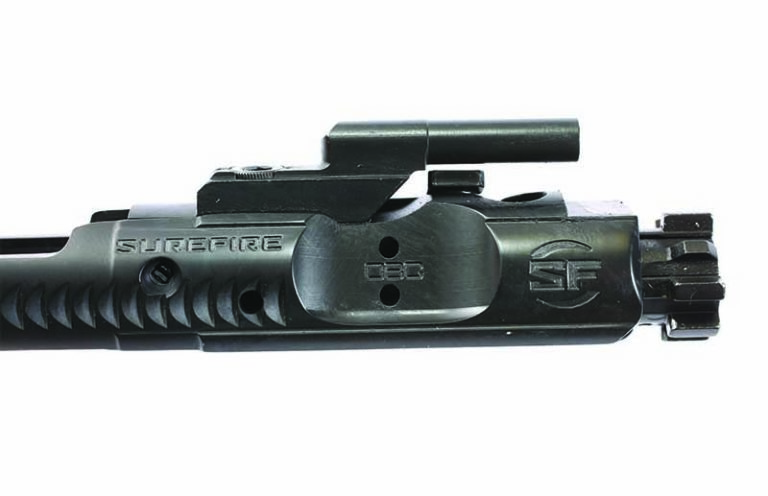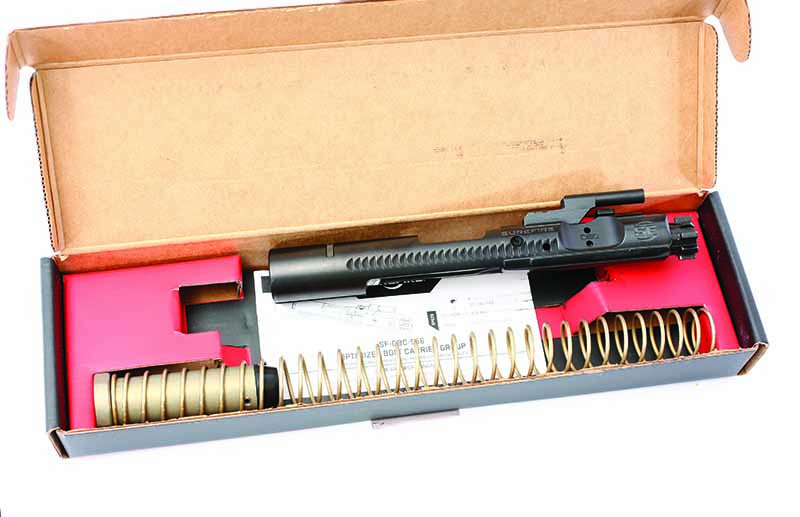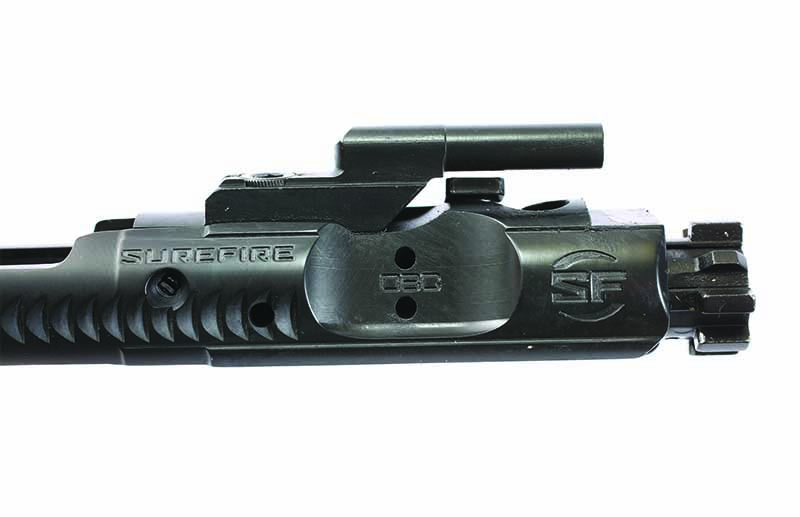
Taming recoil and preventing wear, the SureFire OBC-556 makes for a more pleasant AR pistol, SBR or even carbine.
How Does The OBC-556 Work:
- The bolt carrier group slows down cycle rate through a number of design changes.
- Cam slot angles and timing changed so it takes longer for the bolt to unlock.
- Dead-blow weight added into the rear of the carrier to slow the BCG's momentum.
- Shorter “H” buffer creates a longer travel distance.
Short barrels, as in AR pistols, are en vogue. And SBRs are all the rage, for those who can get them. They do, however, have problems. Basically, they require such a sharp gas input to jolt the system into working that they can be harsh in recoil. Adding in a heavier buffer helps, but sometimes you need more. Enter SureFire and their Optimized Bolt Carrier.
The OBC-556 was designed by Jim Sullivan, who was the guy who debugged the initial AR-15 for Eugene Stoner and Armalite. I had a chance to visit him a while back (a story for another time) and got the lowdown on the OBC, which he was doing with and for SureFire.

The OBC slows down your ARs cyclic rate by means of three design changes Sullivan put into it. First, he went into the cam slot on the carrier and changed the angles and timing on that, so the carrier has to work harder and takes longer to unlock the bolt. Second, he put a dead-blow weight into the rear of the carrier, so the carrier movement has to “pick up” the weight as it cycles. That slows it down some more. And third, in conjunction with a stronger buffer spring, he installed an “H” buffer, but one that’s shorter. To accommodate the shorter buffer, the gas key is shorter (so it won’t hit the rear ring of the receiver, another story to tell at a later time) and travels longer.
The end result is a bolt that takes longer to unlock, moves slower because of the added weight, and travels a longer distance, which also adds time. Your AR pistol, SBR, and even carbine or rifle shoot softer. And since the bolt takes more time to travel, this gives your magazines a better chance to lift the cartridge stack and have the top round firmly pinned against the feed lip on its side, ready to feed as the bolt comes forward.
Get On Target With The AR:
- Go Small With These 8 Economical AR Pistol Options
- 8 Budget AR-15 Options: More Bang For The Buck
- AR-15 Lower: Putting The Internals Together
- AR-10 vs. AR-15: How Stoner’s Rifles Stack Up
- How It Works: The AR-15 Upper
Does The OBC-556 Make A Difference?
You’re thinking, “This is all well and good, but does it really make a difference?” Well, that depends. If your AR is a bit marginal, or it gets cranky when it gets dirty, then yes. If you find weather changes can mean reliability changes, then yes again. If your AR has been utterly reliable in all situations, with all ammo, and never failed—then I really can’t say this will improve on that. But … it won’t make it worse.
To test the changes, I took advantage of an opportunity: a day with a select-fire AR lower. No, not an M16/M4, because it didn’t leave the factory that way, but a “papered” select-fire lower—an R&D project by a local manufacturer.
I tested it with two uppers, an M4 clone from Bravo Company and an 11.5-inch SBR upper, also a product of BCM. I used two types of ammunition, Federal XM193 and Hornady Frontier .223 Rem., both 55-grain FMJ, because they’re common.

The M4 upper, with a “H” buffer (normal in a lot of ARs) ran at 800 rpm with XM193, and 763 rpm with the Hornady. Using the SureFire OBR, the XM193 ran at 702 rpm, and the Hornady was 696 rpm. That’s a 12 percent and 9 percent reduction in cyclic rate, respectively.
The 11.5-inch upper has XM193 running at 797 rpm and the Hornady at 775 rpm. With the SureFire OBC installed, the rates were 705 and 688 rpm, respectively. Again, 12 percent and 11 percent reductions.
The OBC also reduced cyclic rates when I installed various suppressors on those uppers, which is where such a setup can really shine. Yes, it was a fun day. Yes, I have a long list of volunteers.
Now, this goodness—indeed, any goodness—does not come free. The OBC-556 has a retail price of $399. However, a box-stock bolt-carrier assembly will run you anywhere from $150 to $225 plus the buffer and spring, and that’s before you go and get any extras such as platings or exotic alloys. So, the SureFire bump isn’t as big as it appears at first blush.
Once you’ve built a few ARs, you might find that you need or want an improvement. SureFire certainly has that for you. And if you’re putting a suppressor on your AR pistol, then the SureFire OBC-556 is a must-have.
For more information on the OBC-556, please visit surefire.com.
Editor's Note: This article originally appeared in the October 2021 issue of Gun Digest the Magazine.

Next Step: Get your FREE Printable Target Pack
Enhance your shooting precision with our 62 MOA Targets, perfect for rifles and handguns. Crafted in collaboration with Storm Tactical for accuracy and versatility.
Subscribe to the Gun Digest email newsletter and get your downloadable target pack sent straight to your inbox. Stay updated with the latest firearms info in the industry.

![Best Concealed Carry Guns In 2025 [Field Tested] Wilson Combat EDC X9S 1](https://gundigest.com/wp-content/uploads/Wilson-Combat-EDC-X9S-1-324x160.jpg)


![Best 9mm Carbine: Affordable PCCs [Tested] Ruger Carbine Shooting](https://gundigest.com/wp-content/uploads/Ruger-Carbine-Shooting-100x70.jpg)
![Best AR-15: Top Options Available Today [Field Tested] Harrington and Richardson PSA XM177E2 feature](https://gundigest.com/wp-content/uploads/Harrington-and-Richardson-PSA-XM177E2-feature-100x70.jpg)
